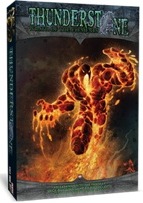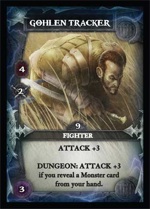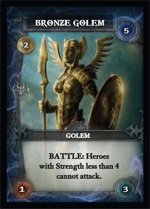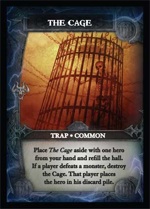by Lee Valentine
 Thunderstone: Wrath of the Elements
Thunderstone: Wrath of the Elements
Published by Alderac Entertainment Group
Designed by Mike Elliott
1-5 players
Contents: 340 cards, full-color rulebook, 76 card dividers, foam storage inserts
$29.99
This game is featured in the OgreCave Christmas Gift Guide 2010.
Thunderstone: Wrath of the Elements ("WE") is the new
expansion for AEG's hit deckbuilding card game Thunderstone ("TS"),
which I previously reviewed here on
OgreCave.com. WE features a new storage box for this
expansion and the original set as well. It also comes with hundreds of
new game cards for use with your TS games.
Packaging & Components
Typically I don't lead off a review with a discussion of the packaging,
but card storage was a problem in the base game, and it's great in this
set. WE comes with a new box and 76 index tabbed dividers. Each
divider has the name of the card it is supposed to be filed with. These
dividers are noticeably taller than the game cards, unlike the dividers
in the original set, which were barely taller than the game cards and
had no names on them. While the dividers keep the cards easy to find,
sponge blocks keep categories of cards separate from each other (like
Village cards and Heroes), and keep the cards from moving in the box
during transport. The blocks are obviously removable to allow for
further expansion cards to fit in this storage box. Overall, the
storage solution is well thought out and appreciated.
WE comes with a rulebook covering the new rules and cards
introduced in this set, but it does not come with a comprehensive
rulebook covering the first two editions of the game. As a result,
those of us with the first edition printing of TS will have to
deal with using a printed PDF of version 1.4 of the core rules plus the
new WE rulebook.
A printed copy of the rules PDF will fit in the WE box if you
trim down the white space on the edges of the rules, but the WE
box is too small to hold the original first edition printing of the
rulebook. This didn't bother me because the original rulebook had so
many flaws in it that I only use a home printed PDF edition of the rules
anyway.
The new game cards have slightly smaller corners than the original
cards, and the color and press coat on the backs don't match perfectly,
occasionally allowing a perceptive player to note whether a new card or
an old card is on the top of his draw pile. Otherwise the cards are
similar in size and shuffle easily enough. Since the cards get shuffled
and drawn so frequently, the minor differences between the original
cards and the new cards did not interfere with play at all. The art on
the cards is generally high quality and thematically appropriate.
New Cards
 There are seven new categories of heroes in the set. Typically the new
heroes are not as good in a fight, pound-for-pound, as some of the
heroes in the base set unless you combo them with other cards. Almost
all the new heroes, however, have interesting metagame effects like the
Blind Neophyte who gains a bonus to attack if he discards a
light-producing item. This is a great way to discard torches or similar
items late in the game if you want to thin your deck. Many of the
original set's heroes were useful during a fight in the dungeon, but
were often chaff in your hand when you are visiting the village to buy
goods and services. Some of the newer heroes have village-related
powers like the Gangland Thug who gains gold for every other hero in
your hand. This is great when you draw a hand of militia who are too
weak to go to the dungeon and are otherwise worth no gold in the
village. Speaking of Militia, there are 30 new copies of the Militia
with the missing "Hero" trait replaced, in case you have a first
printing of the game. Most other cards with errata were not replaced.
There are seven new categories of heroes in the set. Typically the new
heroes are not as good in a fight, pound-for-pound, as some of the
heroes in the base set unless you combo them with other cards. Almost
all the new heroes, however, have interesting metagame effects like the
Blind Neophyte who gains a bonus to attack if he discards a
light-producing item. This is a great way to discard torches or similar
items late in the game if you want to thin your deck. Many of the
original set's heroes were useful during a fight in the dungeon, but
were often chaff in your hand when you are visiting the village to buy
goods and services. Some of the newer heroes have village-related
powers like the Gangland Thug who gains gold for every other hero in
your hand. This is great when you draw a hand of militia who are too
weak to go to the dungeon and are otherwise worth no gold in the
village. Speaking of Militia, there are 30 new copies of the Militia
with the missing "Hero" trait replaced, in case you have a first
printing of the game. Most other cards with errata were not replaced.
There are 14 new types of village cards in WE. Just as some of
the heroes helped to add value to cards that otherwise were chaff late
in the game, some of the village cards enhance characters from the first
set. An example of this is the Short Bow, which grants a +3 to attack
versus the monsters in the second and third rank (read "levels") of the
dungeon, but grants additional bonuses in the hands of one of the
archers from the base set. Most of the village cards were interesting,
but some, like Ambrosia, are minor twists on cards in the first set.
Depending on the monsters and other village cards in play, you may
always prefer to buy Ambrosia, as opposed to Feast, or vice versa,
effectively limiting your play options if both are in play in the
village at one time. This may occasionally make you want to tweak the
randomly selected setup to "cure" this if you perceive it as a problem
with diversity in the Village's marketplace.
 There are four new categories of monsters in this set: two sets of
elementals, one set of golems, and a new type of monster called the
Horde. The Horde is effectively a very vanilla monster, but a special
mechanic in the game makes each horde card more difficult to kill than
the last one (and potentially worth more victory points as well). The
golems and elementals are often very difficult to kill – so difficult,
in fact, you may be hard-pressed to come up with the tools to kill them.
Only characters with high strength can attack the golems, for example
(finally a good use for those Iron Rations that are always clogging up
your deck late in the game). Some of the new monsters have so many
attack restrictions on them that they are only beatable by amassing
level two and level three heroes in your deck. This is easier to do in
a three or four player game because more hero purchases brings these
valuable heroes to the top of the hero village decks more quickly. When
playing with two-players (or using the solo play variant), it's harder
to get these higher-level heroes and harder, therefore, to beat some of
the tougher new monsters. This creates a sweet spot in the number of
players which I'm guessing is three or four total players, but I cannot
say that with certainty.
There are four new categories of monsters in this set: two sets of
elementals, one set of golems, and a new type of monster called the
Horde. The Horde is effectively a very vanilla monster, but a special
mechanic in the game makes each horde card more difficult to kill than
the last one (and potentially worth more victory points as well). The
golems and elementals are often very difficult to kill – so difficult,
in fact, you may be hard-pressed to come up with the tools to kill them.
Only characters with high strength can attack the golems, for example
(finally a good use for those Iron Rations that are always clogging up
your deck late in the game). Some of the new monsters have so many
attack restrictions on them that they are only beatable by amassing
level two and level three heroes in your deck. This is easier to do in
a three or four player game because more hero purchases brings these
valuable heroes to the top of the hero village decks more quickly. When
playing with two-players (or using the solo play variant), it's harder
to get these higher-level heroes and harder, therefore, to beat some of
the tougher new monsters. This creates a sweet spot in the number of
players which I'm guessing is three or four total players, but I cannot
say that with certainty.
The difficulty of the new monsters will occasionally force a player to
spend a turn in the dungeon to chase away an unkillable monster. This
will cycle in a new monster that can be dealt with more easily. This
would be a strategy that tends to benefit your opponents but for the
presence of a new "Dungeon Feature" called "Traps".
There are three new Dungeon Features in this set: Dire Traps, Death
Traps, and Guardians. Dire Traps and Death Traps are new categories of
cards that are shuffled into the Dungeon Deck with the monsters for the
game. Like Monsters, they appear in one of the three ranks of the
dungeon. Immediately after being revealed, a trap takes effect and is
replaced by another card in the Dungeon Deck. Dire Traps cause minor
misfortunes like giving players Disease cards. Death Traps kill heroes
outright. Some of these only affect the "other players" (i.e., everyone
other than the player currently taking a turn), punishing people who
weren't brave enough to enter the dungeon.
There is only one Guardian in WE, the "Dark Champion". Guardians
can create a fourth rank of monster to face (they can move to Rank 0).
They are powerful and tend to have a negative impact on the players each
turn they are in play. During Dungeon Deck construction Guardians are
placed toward the bottom of the deck, generally signaling that the game
is at least half way over.
All these new Dungeon Features have corresponding randomizers in the
Monster Randomizer deck, but you always play with at least three monster
types to fight. The new setup rules will then cause you to build a
Dungeon Deck that is between 31 and 44 cards deep. Of course, when the
Dungeon Deck is larger the game lasts a proportionally longer period of
time.
There is also a new type of Thunderstone card. It is worth only one
point instead of three, for those players who felt a three point
Thunderstone added too much to the score of the player who was lucky
enough to find it. This new Thunderstone also acts as a light source in
some of the optional multi-game campaign variants included in the
rulebook.
New Gameplay Variants & New Rules
The WE rulebook includes a wide variety of different optional
play variations for use with TS. The first of these is a solo
variant – this is just a printed version of the rules available on the
AEG website since shortly after the base set's release. I used to
regularly win solo games of TS, but the new monsters can really
make these games more difficult.
 There are also variant rules for playing multiple games of TS in
a row, in campaign format – using multiple Thunderstones, for example,
along with more than three monster types at a time. The ideas presented
are solid ones for players looking for a whole evening of TS. I
likely won't play them very often as the inclusion of the new Dungeon
Features plus the difficulty of the new monsters tends to make games
even longer than they were initially. A last set of variants are
pre-set collections of village, hero, and monster cards that have a
specific theme (like "holy war"). Theme is where TS really beats
out Dominion, so this was a pleasant option to see.
There are also variant rules for playing multiple games of TS in
a row, in campaign format – using multiple Thunderstones, for example,
along with more than three monster types at a time. The ideas presented
are solid ones for players looking for a whole evening of TS. I
likely won't play them very often as the inclusion of the new Dungeon
Features plus the difficulty of the new monsters tends to make games
even longer than they were initially. A last set of variants are
pre-set collections of village, hero, and monster cards that have a
specific theme (like "holy war"). Theme is where TS really beats
out Dominion, so this was a pleasant option to see.
There are a couple of gray areas in the new rules. Some of these are
exacerbated if you have the first edition of the base game, as there are
errors on a few cards from that set which can make you scratch your head
when resolving some cards from WE. The second printing of the
base TS game has a lot of the wording problems ironed out, so if
you have that, some of these gray areas go away entirely.
Conclusions
TS continues to impress me, except for the usability of the
cards' trade dress, which can make it pretty difficult to introduce this
game to non-gamer geeks. One thing I wished that had been shipped with
this set but wasn't is a set of -2 "light penalty" counters. The light
mechanic in TS is sometimes onerous to calculate without using
special counters. While I have homemade counters for this purpose, many
other players would benefit from such a resource.
Overall this set adds a lot more difficulty as well as some additional
time to the length of each game, making it most appropriate for people
who are already familiar with the base set of cards. On average, our
two- and three-player games have run around two hours of play time.
The new game cards alone would make Thunderstone: Wrath of the
Elements a good expansion for Thunderstone. However, the
packaging was a hit with me, and that makes this a "must have" expansion
if you are a fan of the base game, particularly considering the price.
For Retailers
I have only played one game of Dominion, but it did not compare
for me in terms of the theme, art quality, and intricacy of TS.
However, Dominion is a much more streamlined game with simpler
rules and a shorter play time, and as such, it has a larger potential
audience than TS does. Wrath of the Elements will
probably not sell as many copies as it would if it were a
Dominion expansion. Still, the art on the box is attractive, and
TS is a popular product with good word-of-mouth. If TS
sells well for you, then you should definitely consider carrying this
product as I expect many people who own the base game will want this
expansion.
Lee's Ratings
Overall: A-
Gameplay: A- (lower if you prefer shorter games)
Rules Clarity: B+ (A- if you are using the second printing of the base set)
Artwork: A
Card Layout: B (due to lack of useful iconography on some cards)
Packaging: A (a highly appropriate packaging design, useful for both storage and transportation)
Retailer Salability: B
Links:
| Related reviews on OgreCave: |
|
|


 Thunderstone: Wrath of the Elements
Thunderstone: Wrath of the Elements There are seven new categories of heroes in the set. Typically the new
heroes are not as good in a fight, pound-for-pound, as some of the
heroes in the base set unless you combo them with other cards. Almost
all the new heroes, however, have interesting metagame effects like the
Blind Neophyte who gains a bonus to attack if he discards a
light-producing item. This is a great way to discard torches or similar
items late in the game if you want to thin your deck. Many of the
original set's heroes were useful during a fight in the dungeon, but
were often chaff in your hand when you are visiting the village to buy
goods and services. Some of the newer heroes have village-related
powers like the Gangland Thug who gains gold for every other hero in
your hand. This is great when you draw a hand of militia who are too
weak to go to the dungeon and are otherwise worth no gold in the
village. Speaking of Militia, there are 30 new copies of the Militia
with the missing "Hero" trait replaced, in case you have a first
printing of the game. Most other cards with errata were not replaced.
There are seven new categories of heroes in the set. Typically the new
heroes are not as good in a fight, pound-for-pound, as some of the
heroes in the base set unless you combo them with other cards. Almost
all the new heroes, however, have interesting metagame effects like the
Blind Neophyte who gains a bonus to attack if he discards a
light-producing item. This is a great way to discard torches or similar
items late in the game if you want to thin your deck. Many of the
original set's heroes were useful during a fight in the dungeon, but
were often chaff in your hand when you are visiting the village to buy
goods and services. Some of the newer heroes have village-related
powers like the Gangland Thug who gains gold for every other hero in
your hand. This is great when you draw a hand of militia who are too
weak to go to the dungeon and are otherwise worth no gold in the
village. Speaking of Militia, there are 30 new copies of the Militia
with the missing "Hero" trait replaced, in case you have a first
printing of the game. Most other cards with errata were not replaced. There are four new categories of monsters in this set: two sets of
elementals, one set of golems, and a new type of monster called the
Horde. The Horde is effectively a very vanilla monster, but a special
mechanic in the game makes each horde card more difficult to kill than
the last one (and potentially worth more victory points as well). The
golems and elementals are often very difficult to kill – so difficult,
in fact, you may be hard-pressed to come up with the tools to kill them.
Only characters with high strength can attack the golems, for example
(finally a good use for those Iron Rations that are always clogging up
your deck late in the game). Some of the new monsters have so many
attack restrictions on them that they are only beatable by amassing
level two and level three heroes in your deck. This is easier to do in
a three or four player game because more hero purchases brings these
valuable heroes to the top of the hero village decks more quickly. When
playing with two-players (or using the solo play variant), it's harder
to get these higher-level heroes and harder, therefore, to beat some of
the tougher new monsters. This creates a sweet spot in the number of
players which I'm guessing is three or four total players, but I cannot
say that with certainty.
There are four new categories of monsters in this set: two sets of
elementals, one set of golems, and a new type of monster called the
Horde. The Horde is effectively a very vanilla monster, but a special
mechanic in the game makes each horde card more difficult to kill than
the last one (and potentially worth more victory points as well). The
golems and elementals are often very difficult to kill – so difficult,
in fact, you may be hard-pressed to come up with the tools to kill them.
Only characters with high strength can attack the golems, for example
(finally a good use for those Iron Rations that are always clogging up
your deck late in the game). Some of the new monsters have so many
attack restrictions on them that they are only beatable by amassing
level two and level three heroes in your deck. This is easier to do in
a three or four player game because more hero purchases brings these
valuable heroes to the top of the hero village decks more quickly. When
playing with two-players (or using the solo play variant), it's harder
to get these higher-level heroes and harder, therefore, to beat some of
the tougher new monsters. This creates a sweet spot in the number of
players which I'm guessing is three or four total players, but I cannot
say that with certainty. There are also variant rules for playing multiple games of TS in
a row, in campaign format – using multiple Thunderstones, for example,
along with more than three monster types at a time. The ideas presented
are solid ones for players looking for a whole evening of TS. I
likely won't play them very often as the inclusion of the new Dungeon
Features plus the difficulty of the new monsters tends to make games
even longer than they were initially. A last set of variants are
pre-set collections of village, hero, and monster cards that have a
specific theme (like "holy war"). Theme is where TS really beats
out Dominion, so this was a pleasant option to see.
There are also variant rules for playing multiple games of TS in
a row, in campaign format – using multiple Thunderstones, for example,
along with more than three monster types at a time. The ideas presented
are solid ones for players looking for a whole evening of TS. I
likely won't play them very often as the inclusion of the new Dungeon
Features plus the difficulty of the new monsters tends to make games
even longer than they were initially. A last set of variants are
pre-set collections of village, hero, and monster cards that have a
specific theme (like "holy war"). Theme is where TS really beats
out Dominion, so this was a pleasant option to see.